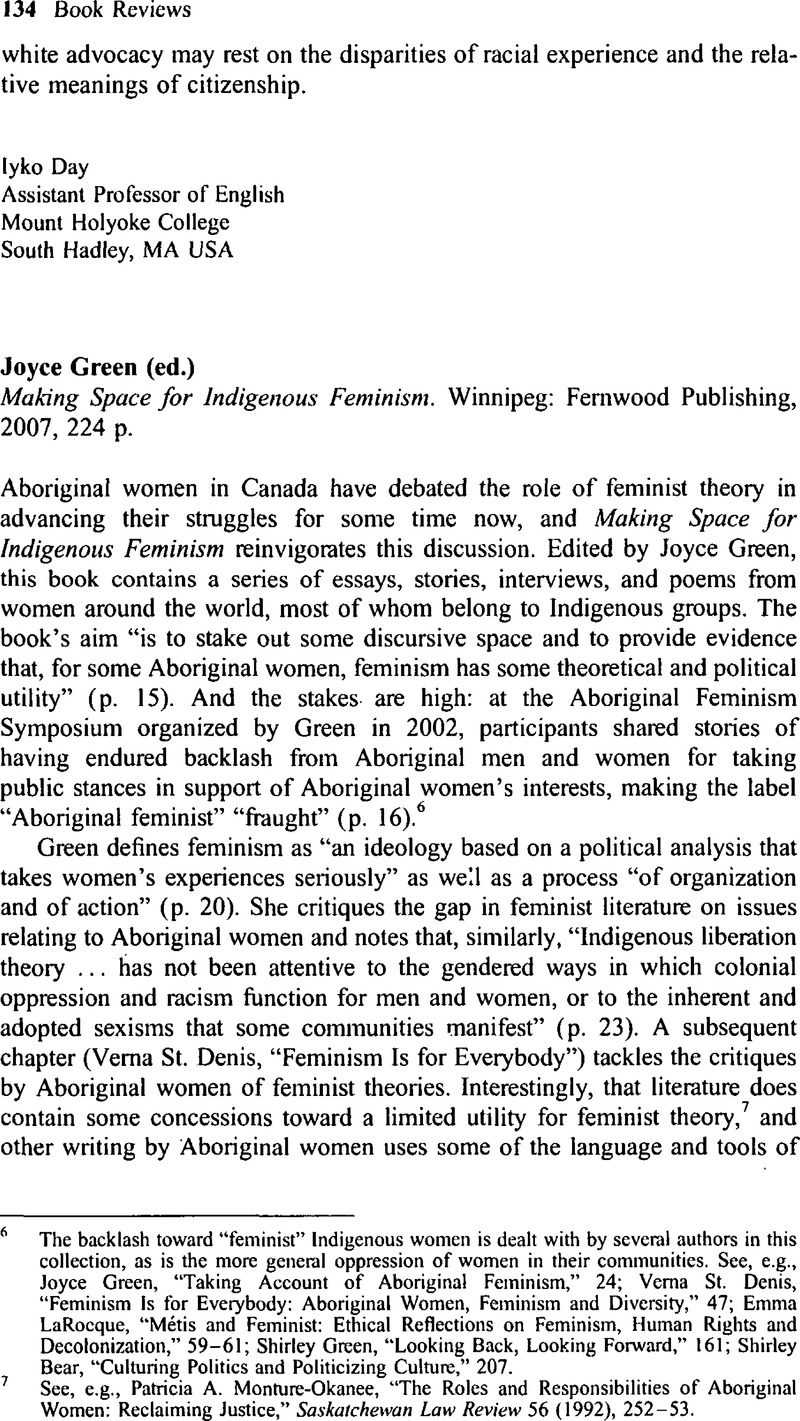Published online by Cambridge University Press: 18 July 2014

6 The backlash toward “feminist” Indigenous women is dealt with by several authors in this collection, as is the more general oppression of women in their communities. See, e.g., Green, Joyce, “Taking Account of Aboriginal Feminism,” 24Google Scholar; Denis, Verna St., “Feminism Is for Everybody: Aboriginal Women, Feminism and Diversity,” 47Google Scholar; LaRocque, Emma, “Métis and Feminist: Ethical Reflections on Feminism, Human Rights and Decolonization,” 59–61Google Scholar; Green, Shirley, “Looking Back, Looking Forward,” 161Google Scholar; Bear, Shirley, “Culturing Politics and Politicizing Culture,” 207Google Scholar.
7 See, e.g., Monture-Okanee, Patricia A., “The Roles and Responsibilities of Aboriginal Women: Reclaiming Justice,” Saskatchewan Law Review 56 (1992), 252–53Google Scholar.
8 See, e.g., Nahanee, Tenessa, “Indian Women, Sex Equality and the Charter,” in Andrew, Caroline and Rodgers, Sanda, eds., Women and the Canadian State (Montreal & Kingston: McGill-Queen's University Press, 1997)Google Scholar.
9 E.g., Henning, Denise K., “Yes, My Daughters, We Are Cherokee Women,” 196Google Scholar.
10 E.g., Denis, St., “Feminism Is for Everybody,” 46Google Scholar; LaRocque, , “Métis and Feminist,” 56–57Google Scholar; Smith, Andrea, “Native American Feminism, Sovereignty, and Social Change,” 104Google Scholar.
11 Several authors refer to the writing of Frantz Fanon, a leading postcolonial theorist. See, e.g., Denis, St., “Feminism Is for Everybody,” 41Google Scholar; Irwin, Kathie, “Maori Women and Leadership in Aotearoa/ New Zealand,” 181Google Scholar. See also Kuokkanen, Rauna, “Myths and Realities of Sami Women: A Post-colonial Feminist Analysis for the Decolonization and Transformation of Sami Society,” 72Google Scholar; Kuokkanen explicitly takes a postcolonial feminist stance.
12 E.g., Denis, St., “Feminism Is for Everybody,” 48Google Scholar; Smith, , “Native American Feminism,” 103Google Scholar.
13 Eikjok, Jorunn, “Gender, Essentialism and Feminism in Samiland,” 115–19Google Scholar.
14 Stewart-Harawira, Makere, “Practising Indigenous Feminism: Resistance to Imperialism,” 127Google Scholar.
15 E.g., LaRocque, , “Métis and Feminist,” 53, 65Google Scholar, writes about the ways in which the particular concerns of Métis women have often been ignored by feminists. See also Eikjok, , “Gender, Essentialism and Feminism,” 113–14Google Scholar; Stewart-Harawira, , “Practising Indigenous Feminism,” 126Google Scholar.
16 Chapters dealing most explicitly with law include Smith, , “Native American Feminism,” 99Google Scholar, discussing the Santa Clara Pueblo v. Martinez case; Green, Joyce, “Balancing Strategies: Aboriginal Women and Constitutional Rights in Canada,” 140Google Scholar; and interviews with Colleen Glenn (p. 233) and Sharon McIvor (p. 241) about their legal activism on Métis and Aboriginal women's rights.
17 E.g., LaRocque, , “Métis and Feminist,” 59Google Scholar; Denis, St., “Feminism Is for Everybody,” 46Google Scholar; Kuokkanen, , “Myths and Realities,” 76Google Scholar; Smith, , “Native American Feminism,” 98, 102–3Google Scholar; Green, Shirley, “Looking Back,” 161Google Scholar; Bear, , “Culturing Politics and Politicizing Culture,” 206Google Scholar. See also Kuokkanen's interview of Tina Beads (pp. 221–32).
18 E.g., LaRocque, , “Métis and Feminist,” 59, 64Google Scholar; Eikjok, , “Gender, Essentialism and Feminism,” 110–11Google Scholar; Green, Shirley, “Looking Back,” 162Google Scholar; Henning, “Yes, My Daughters.” See also LaRocque's, poem “My Hometown Northern Canada South Africa,” 218Google Scholar.
19 E.g., LaRocque, , “Métis and Feminist,” 61Google Scholar; Kuokkanen, , “Myths and Realities,” 82Google Scholar; Smith, , “Native American Feminism,” 100–101Google Scholar.